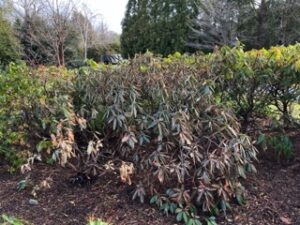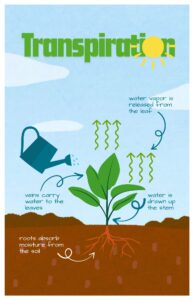WHY WINTER BURN HAPPENS
It all boils down to a thirsty plant in a frozen world. Even in winter, broadleaf evergreens continue to lose moisture through their leaves. Normally, their roots would slurp up water from the soil to replace it—but when the ground is frozen solid, it’s like trying to drink through a straw that’s been welded shut. Add in harsh winds and bright winter sun, and you’ve got a recipe for crispy, brown leaves.
SIGNS YOUR EVERGREENS ARE SUFFERING
- Leaves turn yellow, bronze, or brown—especially on the windward and sun-exposed sides.
- Rhododendron leaves curl up tighter than a sleeping cat.
- Severe cases lead to dead branches, making your “evergreens” look suspiciously like “nevergreens.”
ABOVE: Following a terrible drought last fall and a very cold winter, rhododendrons naturally curl up when temperatures get cold as a defense mechanism. By now, they would normally be opening back up. They are recovering very slowly, due to the lack of moisture in the ground.
HOW TO PREVENT THE FADE-TO-BROWN TRAGEDY
Hydration is Key – Give your evergreens a long, deep soak before the ground freezes in late fall. Think of it as a farewell drink before winter dormancy.
Mulch Like You Mean It – A layer of mulch (2-3 inches thick) around the base helps insulate the soil and lock in moisture.
Create a Wind Shield – Set up burlap screens or plant natural windbreaks to block those harsh winter gusts.
Spray and Stay Green – Anti-desiccant sprays (like PlantCoatPro™) coat the leaves and reduce moisture loss.
Choose Wisely – If planting new broadleaf evergreens, place them where they get some shade and protection from the worst winter elements.
Say No to Late Fertilizing – Stop using nitrogen-heavy fertilizers by mid-summer. New, tender growth in fall = disaster in winter.
HOW TO HELP WINTER-BURNED PLANTS RECOVER
If your plants already look worse for wear, don’t grab the shovel just yet. Instead:
Wait and Watch – Some plants bounce back once spring growth begins.
Prune with Care – Remove dead branches, but don’t go overboard—new growth might surprise you.
Water Generously – A steady supply of water in early spring can help stressed plants recover.
Give a Gentle Boost – A balanced, slow-release fertilizer in the spring can give your plants the nutrients they need to rebound.
THE FINAL WORD
Winter burn is a harsh reminder that even tough evergreens need a little TLC when temperatures drop. But with the right prep work, you can keep your plants from looking like they just barely survived the apocalypse. So hydrate, mulch, protect—and when spring rolls around, they’ll reward you by being gloriously green instead of painfully brown.
As for the ultimate fate of this year’s rhododendrons, it remains to be seen. There has not been a drought so severe in the fall in recent history. The rhododendrons continuing to stay curled now that the temperatures are warm is due to that drought. Newly planted rhododendrons and those dealing with other problems may not survive. Most, if they were well established and otherwise healthy, should put out new growth in May and June. Those suffering from very bad winter burn will look unsightly until the new growth emerges.





Recent Comments